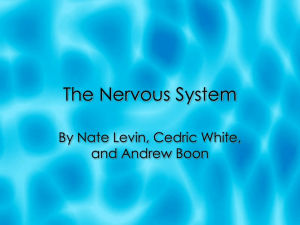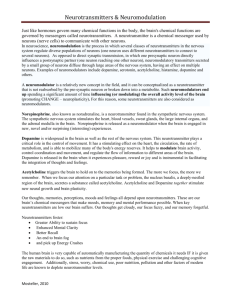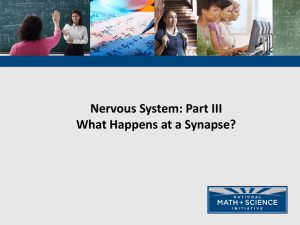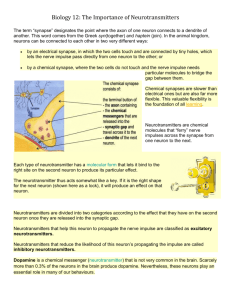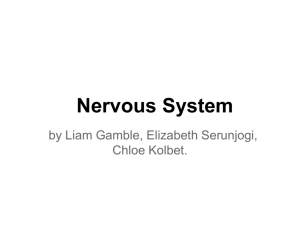A5 Neuropharmacology - Ms De Souza's Super Awesome IB
advertisement
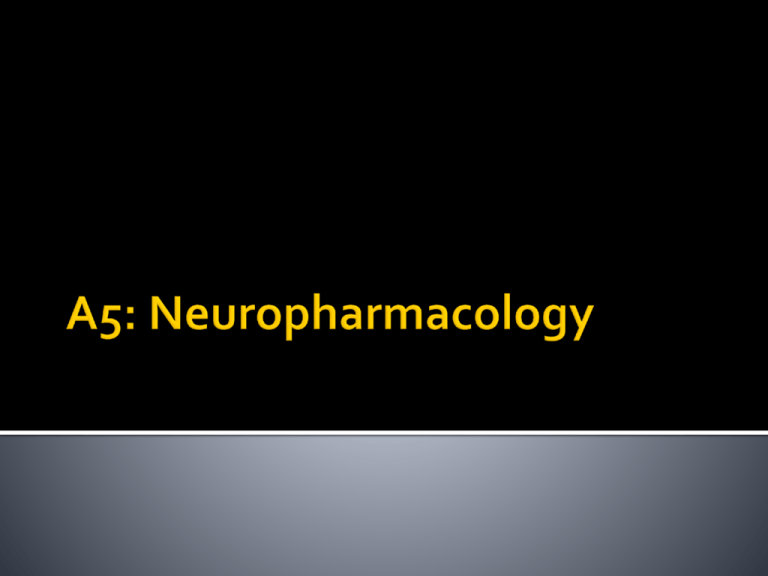
Neurotransmitters can be either excitatory or inhibitory. Excitatory neurotransmitters – promote an action potential to occur in the post synaptic neuron Inhibitory neurotransmitters – make it more difficult for an action potential to occur in the post synaptic neuron Generates an action potential in the post synaptic neuron A neurotransmitter is released from the presynaptic neuron and causes the post-synaptic neuron to open its Na+ channels. If the post synaptic neuron was originally at a resting potential of -70mV, when Na+ enters the neuron, the membrane potential increases to become close to zero (it’s depolarized!) If threshold levels are reached, this is the generation of an action potential in the post synaptic neuron and thus the transmission of a nerve impulse from one neuron to another This is when a post synaptic neuron is inhibited from producing an action potential (and thus continuing a nerve impulse) HOW? Inhibitory neurotransmitters make the post synaptic neuron more negative Post synaptic neurons open it’s Cl- channels, allowing Cl- to enter the neuron This hyperpolarizes the membrane (makes it more negative) Ie: a membrane potential lower than -70mV (Another method could be the opening of K+ channels to cause K+ to move out of the neuron which would also make the neuron more negative) This makes is more difficult to generate an action potential on the post-synaptic membrane because the resting potential is now further away from the threshold value. The means that a nerve impulse will (likely) not be transmitted from neuron to neuron Decision making is the summation of EPSP and IPSP signals More than 1 pre-synaptic neuron can form a synapse with the same post-synaptic neuron If the sum of the signals is excitatory, the axon fires If the sum of the signal is inhibitory, the axon does not fire. If there are more EPSPs than IPSPs, then an action potential will be generated. The neurotransmitters we’ve discussed so far have all been fast-acting, crossing the synaptic cleft and binding to receptors less than a millisecond after an action potential arrived at the pre-synaptic membrane. Some neurotransmitters are slow-acting or neuromodulators and take hundreds of milliseconds to act on the post-synaptic membrane. Instead of acting on a single post-synaptic neuron, they diffuse into the surrounding fluid and act on groups of neurons. Ex: noradrenalin/norepinephrine, dopamine, and serotonin are slow acting neurotransmitters. Slow acting neurotransmitters do not affect ion movement across the post synaptic membranes directly but instead cause the release of secondary messengers inside post synaptic neuron which regulate fast synaptic transmission. In this way they can modulate fast acting neurons for relatively long periods of time. Involve changes in neurons caused by neuromodulators. Neuromodulators release secondary messengers inside the post-synaptic neurons and can promote synaptic transmission by increasing the number of receptors in post- synaptic membrane chemical modification to increase the rate of ion movements when a neurotransmitters binds The secondary messengers can persist for days and cause what is known as long-term potentiation (LTP), allowing new synapses to form in the hippocampus and other areas of the brain. This is central from memory and learning. Remember, neurotransmitters are chemicals that allow neurons to communicate with each other. There are over a hundred different brain neurotransmitters The two main excitatory neurotransmitters are acetylcholine and noradrenalin. The two classes of neurotransmitters are cholinergic and adrenergic CHOLINERGIC ADRENERGIC Ex of Neurotransmitter Acetylcholine - Released by all motor neurons - Activated skeletal muscle Noradrenalin - Hormone and a neurotransmitter - Most important role is effect on heart - Also increase blood flow to skeletal muscles and glucose release System Parasympathetic - Ie involved in relaxation Sympathetic - Ie involved in “fight or flight” reactions Effect on Mood Calming effect on mood Increase alertness, energy, and euphoria Neurotransmitter produced by the brain It causes you to feel good Any activity that increases the effect of dopamine is potentially addictive because the individual will want to continue the “good feelings” it creates. Many drugs interfere with dopamine and extend the time this substance is found at the synapse, which make us feel good. In drug addiction, dopamine receptors are constantly stimulated. Over stimulation, decreases the number of dopamine receptors (desensitization) As a result, when the drug has worn off, users experience less joy (because less receptors) out of every day events – thus, reinforcing drug use Also, drug intake needs to be increase to achieve the same “high” Can affect the brain and personality by either increases or decreasing post-synaptic transmission Psychoactive drugs affect the level of neurotransmitters In this way they can increase or decrease post synaptic transmission Enhance the release of a neurotransmitters 1) 2) Ex: Ecstasy Increases euphoria, diminishes anxiety Stop the release of a neurotransmitter Mimic the effect of a neurotransmitter 3) Ex: LSD, morphine and heroin Mimic endorphins which are natural pain killers Block the removal of a neurotransmitter from the synapse (and prolong the effect of the neurotransmitter) 4) Ex: Cocaine Block the receptors of the neurotransmitter (preventing depolarization or hyperpolarization) 5) PCP/Angel Dust Encourage synaptic transmission For many drugs, after frequent use, the number of receptors on the post-synaptic membrane are reduced which leads to a decrease in the affect of the drugs. Increasing doses are needed to obtain the same affect. Examples: Nicotine, Cocaine, Amphetamines These are drugs that promote activity of the nervous system (by mimicking the sympathetic nervous system) Make the user more alert, energetic, and selfconfident. Many excitatory drugs are stimulants Some mild simulants are present in food and drinks such caffeine in coffee, tea, soft drinks May be prescribed to treat depression and narcolepsy Found in cigarettes Is both a stimulant and a relaxant As a stimulant, it causes an increase in adrenaline which increases heart rate, blood pressure and blood sugar levels. As a result it may appear to increase concentration Effect can also reduce appetite As a relaxant it mimic acetylcholine Acts on cholinergic synapses of the body and brain to release dopamine – which causes pleasure and makes it addictive A stimulant made from extracts of the Coca plant Stimulates the CNS and causes feelings of euphoria, talkativeness, increased mental alertness. Temporary decrease in need for food and sleep. Large amounts will cause erratic and violent behaviour Blocks the re-uptake of dopamine, so dopamine accumulates in the synapse Thus addictive feelings of happiness are created (Cocaine is highly addictive) It also makes the user feel less tired or hungry and enhances endurance The “high” that cocaine provides is usually followed by a “crash” when the effect of the drug wears off resulting in depression, irritability, and paranoia Remember, the brain will reduce the number of dopamine receptors when overloaded with cocaine Thus, when drug has worn off, users experience less joy from everyday life further reinforcing increase cocaine use. Drug Free World (8 min) http://www.drugfreeworld.org/real-lifestories/cocaine.html ASAP Science https://www.youtube.com/watch?v=vxI7PTVRfhQ For chenchen https://www.youtube.com/watch?v=PoGXr6hUTD4 Stimulate the CNS cause the release of noradrenaline and dopamine and inhibit their uptake This leads to increased concentration and performance 10 years of drug abuse http://www.youtube.com/watch?v=Opi_Eac MJcg Mimics dopamine. Binds to dopamine receptors (on post synaptic membrane) Used for treatment in the early stages of Parkinson’s disease to reduce the effects of insufficient dopamine secretion. Also used as an anti-depressant Parkinson’s http://www.pennmedicine.org/encyclopedia/em_DisplayAnimation.aspx?gcid=000095&ptid=17 Reduce synaptic transmission Many are sedatives Examples Benzodiazepines Alcohol Tetrahydrocannabinol (THC) Tranquilizers which slow down the CNS Ex: Valium (Diazepam), which can be used to treat anxiety, insomnia, and muscle spasms They hyperpolarize the post-synaptic membranes so that impulses are not sent (increase release of neurotransmitter GABA which causes Cl- to enter neuron) Depresses the CNS It reduces social inhibitions and makes the person feel cheerful and relaxed. It causes a receptor of GABA to remain open longer, further hyperpolarizing the postsynaptic membrane This explains the sedative effect of alcohol (Also helps to increase the release of dopamine – but not well understood how) Found in the Cannabis plant (marijuana) Causes relaxation and can act as a pain killer by binding to the endorphin receptors causing hyperpolarization Often create feelings of lightheadedness and increased appetite. Other receptors it binds to (cannabinoid receptors) will negative affect mental and physical activities: Learning Coordination Problem solving Short term memory Affects hippocampus of the brain, which is important for short-term memory. Affects cerebellum (involved in coordination) which causes motor impairment The impairment of memory and decision making abilities cause students using THC to statistically gain lower grades than those not using it. Scientific research is not unified either way on THC being addictive or not Marijuana and the brain http://www.youtube.com/watch?v=oeF6rFN9 org Act by interfering with neural transmission between areas of sensory perception and the CNS, causing the temporary loss of sensation in all or parts of the body Local anaesthetics (such as those used by the dentist or when getting stiches) cause numbness in an area of the body A patient who has been given a general anaesthetic will normally have no awareness of the medical procedures they have undergone as they are unconscious and lack total sensation. Inhibit sensory organs as will as signals to motor neurons Drug Addiction is the repeated and compulsive use of psychoactive drugs Can be affected by genetic predisposition, social environment, and dopamine secretion Controversial Studies have shown that if there is one addictive person in a family, there is a greater chance of there being another Believed there is an “addiction gene” that may be turned on in an individual due to environmental context One example is the DRD2 gene, which codes for the dopamine receptor protein. There are multiple alleles of this gene and recent studies have shown that people with the A1 allele for the gene consumed less alcohol than those homozygous for the A2 allele for the gene. There is an increased chance of addiction for people: living in an environment where there is substance abuse Who suffer from a childhood trauma and/or neglect Psychoactive drugs may become a way for dealing with this May addictive drugs (including opiates, cocaine, nicotine, alcohol) affect dopamine secretion, causing prolonged periods of high dopamine levels in the brain.

